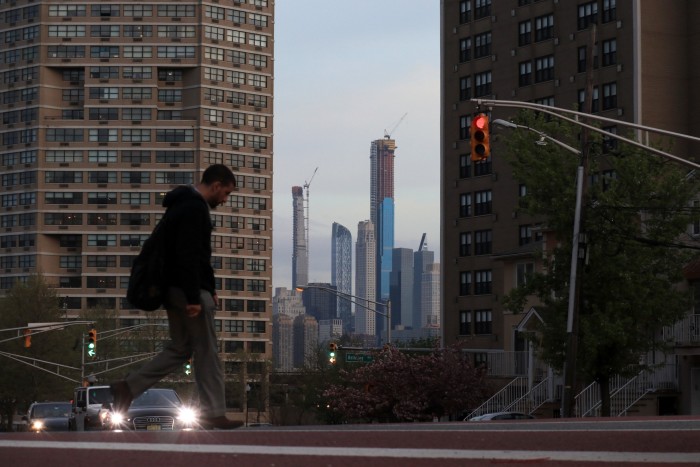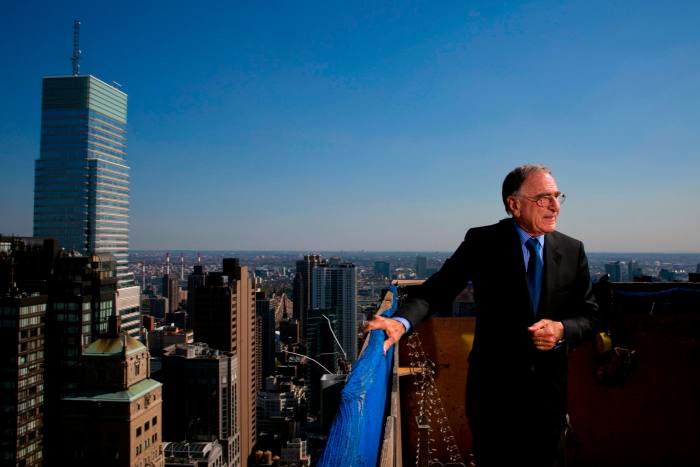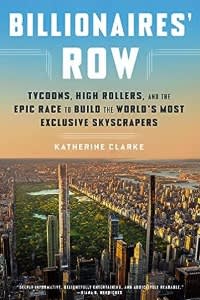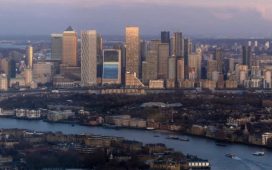
Some years hence, anthropologists or aliens will look to a half-dozen spindly towers that rise improbably high above the southern edge of New York’s Central Park when trying to understand this particular age of hyper-wealth. In the meantime, the rest of us can consult Billionaires’ Row, Katherine Clarke’s thrilling chronicle of those towers and the people who built them.
Known as “supertalls”, those skyline-altering, ultra-luxury condominiums were built in a frenzy after the 2008 financial crisis for the world’s 0.001 per cent — or those willing to shell out $91mn for a penthouse featuring the world’s highest infinity pool. (Heated, of course). They have provoked intense debate about the grotesque inequality they represent, the triumph of global wealth, their architectural merits — or lack thereof — and the shadows they cast over the public park below.
Clarke, a real estate reporter at The Wall Street Journal, explores all these issues. But Billionaires’ Row is ultimately devoted to the larger-than-life characters — more street-smart rogues than Harvard MBAs — who managed to erect these monuments against immense financial, engineering and legal obstacles. It is a kind of heroes’ tale written by someone who is well aware of the heroes’ hair-sprouting warts but cannot help but marvel at their chutzpah.
“Some of the men behind these towers are gifted showmen, others are numbers guys. Some fancy themselves architectural visionaries, while others thrive at the strategic art of negotiation and land assemblage,” writes Clarke. She then adds that for all their “differences and peccadilloes” these men — and they are all men — share a few important traits. “They are all risk takers and swashbucklers, seemingly immune to the incredible pressures that would crush most of us.”
Chief among them is the boom-and-bust Harry Macklowe, who spins his wheels in advertising before finding his calling as a property developer and art collector. Macklowe is on top of the world after paying a record sum for the General Motors Building in 2003 and installing the iconic Apple Store at its base — only to give it all back in 2008 after the financial crisis strikes.
His planned super-tall at 432 Park Avenue is a chance at redemption. It is an odyssey, as Clarke entertainingly recounts, that begins with a high-stakes meeting with a Kabbalah-inclined rabbi to try to persuade a diamond merchant who caters to famous rappers and professional athletes to relocate his studio. Hunting for cash, Macklowe then dallies with a Ukrainian oligarch and a former Trump henchmen, among others — all while skating on the edge of bankruptcy.
“The one disappointment in my life is that my parents are not alive to see that their son built a building that is as tall as the Empire State Building,” he tells Clarke, revealing the boyish dreamer beneath the demanding tycoon.

Manhattan’s supertalls grew in a particular soil and climate. In Asia and the Gulf states, national prestige propelled biblical towers such as Dubai’s Burj Khalifa. There were more commercial factors at work in the transformation of Midtown’s 57th Street from an outpost, as Clarke notes, of schlocky souvenir shops to one of the world’s glitziest addresses.
A watershed was the debut of Trump Tower in 1983. For the new rich, it created a gilded alternative to the famously stuffy co-op buildings of the Upper East Side that delighted in turning away the likes of Madonna and Ukrainian magnate Len Blavatnik. Unlike the co-ops, condos did not inspect every inch of your finances or your family’s provenance. They did not even need to know who you were, allowing buyers to shield their identity with shell companies.
Then came London, and the super-wealthy Russians and Chinese who began moving their fortunes there in the 1990s. Surely, New York could cash in, too, savvy developers reckoned? By taking advantage of “air rights” — the unbuilt space above a property — and new engineering techniques, they plotted unusually tall and slim residential towers in and around 57th Street, looking on to Central Park. Going higher meant more views to sell, and so more money.
Fortune favours the bold, as the sage Matt Damon once said while touting cryptocurrency, and so it did Gary Barnett, a rabbi’s son who cut his teeth in the Antwerp diamond trade. Barnett had the nerve to embark on the 306 metre-tall One57 in the midst of the global financial crisis, betting there would be a market of eager billionaires when the sky stopped falling. “He was the only one who kept his shovel in the ground and kept building. Everybody else pulled back because they were terrified of that mortgage crisis,” estate agent Nikki Field tells Clarke.

Barnett is rewarded when Michael Dell pays a then-record $100.5mn for One57’s penthouse. Hot on his heels comes Macklowe with the 426 metre 432 Park Avenue, and then Steve Roth, the bruising head of Vornado Realty Trust, and Michael Stern, a wunderkind with a mysterious past. The race for the heavens is on.
One of the virtues of Billionaires’ Row is that Clarke knows the trade. She walks readers through the intricacies of site assemblage and the complexities of the “capital stack”. She details the showmanship employed by peacocking super-agents to sell a non-existent property to a multibillionaire.
The opulence becomes sickening. Macklowe outfits his elevator cabs with tan Hermès leather. There are single-slab Italian marble bath tubs: each slab costs $130,000 and forms two tubs.
Naturally, things go bad. Critics will decry the finished One57 as the Manhattan’s ugliest building and popular outrage builds against soulless towers that often house shady wealth — not actual people. Sales begin to slow. Meanwhile, Macklowe’s masterpiece is marred by tenant lawsuits alleging shoddy workmanship. He ends up suing his son and leaving his wife of nearly six decades in one of New York’s most hideous divorces.
Roth emerges triumphant. He wisely eschews dazzle at his Central Park South tower for the classical taste of Robert A.M. Stern Architects. Hedge fund king Ken Griffin ends up paying a staggering $240mn for a multi-floor penthouse, making Dell’s purchase seem quaint.
More poignant is the fate of Stern’s 111 West 57th. It is a supertall that will, improbably, shoot like a needle through the landmarked Steinway piano building. The design is breathtaking. But it takes far too long to build. Along the way, Stern picks an ill-judged fight with New York’s construction unions. The partners brawl as capital calls mount and Clarke captures the agony of a project gone bad. “Easy to throw potshots from Florida. Fuck you,” Stern writes to a partner, at one point.
Today, 111 West 57th is now standing, a shimmering tower laden with unsold units and soured financial dreams. When I met Stern a few years ago, he seemed oddly sanguine as he admired his indelible mark on the skyline. In the tradition of New York’s great developers he was looking up — not much concerned with the mortals and the shadows down below.
Billionaires’ Row: Tycoons, High Rollers, and the Epic Race to Build the World’s Most Exclusive Skyscrapers by Katherine Clarke Currency $25, 384 pages
Joshua Chaffin is the FT’s New York Correspondent
Join our online book group on Facebook at FT Books Café












